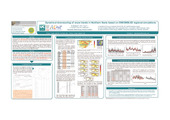Por favor, use este identificador para citar o enlazar este ítem:
http://hdl.handle.net/20.500.11765/7305
Dynamical downscaling of snow trends in Northern Iberia based on ENSEMBLES regional simulations
Registro completo de metadatos
| Campo DC | Valor | Lengua/Idioma |
|---|---|---|
| dc.contributor.author | Herrera García, Sixto | es_ES |
| dc.contributor.author | Pons Reynés, María Rosa | es_ES |
| dc.contributor.author | Sordo, Carmen María | es_ES |
| dc.contributor.author | Gutiérrez Llorente, José Manuel | es_ES |
| dc.date.accessioned | 2017-07-13T06:02:24Z | - |
| dc.date.available | 2017-07-13T06:02:24Z | - |
| dc.date.issued | 2010 | - |
| dc.identifier.citation | European Geosciences Union General Assembly (2010) | es_ES |
| dc.identifier.uri | http://hdl.handle.net/20.500.11765/7305 | - |
| dc.description | Póster presentado en: European Geosciences Union General Assembly 2010 celebrada del 2 al 7 de mayo de 2010 en Viena | es_ES |
| dc.description.abstract | A recent study reported a significant decreasing trend of snow occurrence (-4.6 days/decade) in the Northern Iberian Peninsula since the mid seventies (Pons et al. 2009). This study was based on observations of annual snow frequency (measured as the annual number of snow days) from a network of 33 stations ranging from 60 to 1350 meters. In the present work we analyze the skill of dynamical downscaling methods to reproduce this trend in present climate conditions and also to further project it into the future from A1B-scenario global simulations. In particular, we consider the regional simulation dataset from the ENSEMBLES project, consisting in ten state-of-the-art Regional Climate Models (RCMs) at 25km resolution run with different forcing/boundary conditions. To this aim we first test the regional models with perfect boundaries considering ERA40; it is shown that after correcting the bias, all the RCMs appropriately reproduce the interannual variability and the observed trends (e.g., the ensemble mean presents a trend of -5.8 days/decade). Then we analyze the results for the present climate 20c3m-scenario global simulations. In this case, the results are quite variable with the larger uncertainty being associated with the particular GCM used (ECHAM5, CNRM or HadCM) with trends ranging from -6.7 to -1.8 days/decade. Finally, the trends obtained for the future 2010-2040 A1B runs range from -5.7 to -1.4 days/decade, indicating a continuous decrease of snow frequency in this region. | es_ES |
| dc.language.iso | eng | es_ES |
| dc.rights | Licencia CC: Reconocimiento–NoComercial–SinObraDerivada CC BY-NC-ND | es_ES |
| dc.subject | Snow trends | es_ES |
| dc.subject | Dynamical downscaling | es_ES |
| dc.subject | ENSEMBLES simulations | es_ES |
| dc.subject | Regional climate scenarios | es_ES |
| dc.title | Dynamical downscaling of snow trends in Northern Iberia based on ENSEMBLES regional simulations | es_ES |
| dc.type | info:eu-repo/semantics/conferenceObject | es_ES |
| dc.rights.accessRights | info:eu-repo/semantics/openAccess | es_ES |
| Colecciones: | EGU General Assembly | |
Ficheros en este ítem:
| Fichero | Descripción | Tamaño | Formato | ||
|---|---|---|---|---|---|
| 2010_EGU_Herrera_Post... | 5,81 MB | Adobe PDF |  Visualizar/Abrir |
Los ítems de Arcimis están protegidos por una Licencia Creative Commons, salvo que se indique lo contrario.





